2012 CHRYSLER TOWN AND COUNTRY radiator cap
[x] Cancel search: radiator capPage 524 of 652
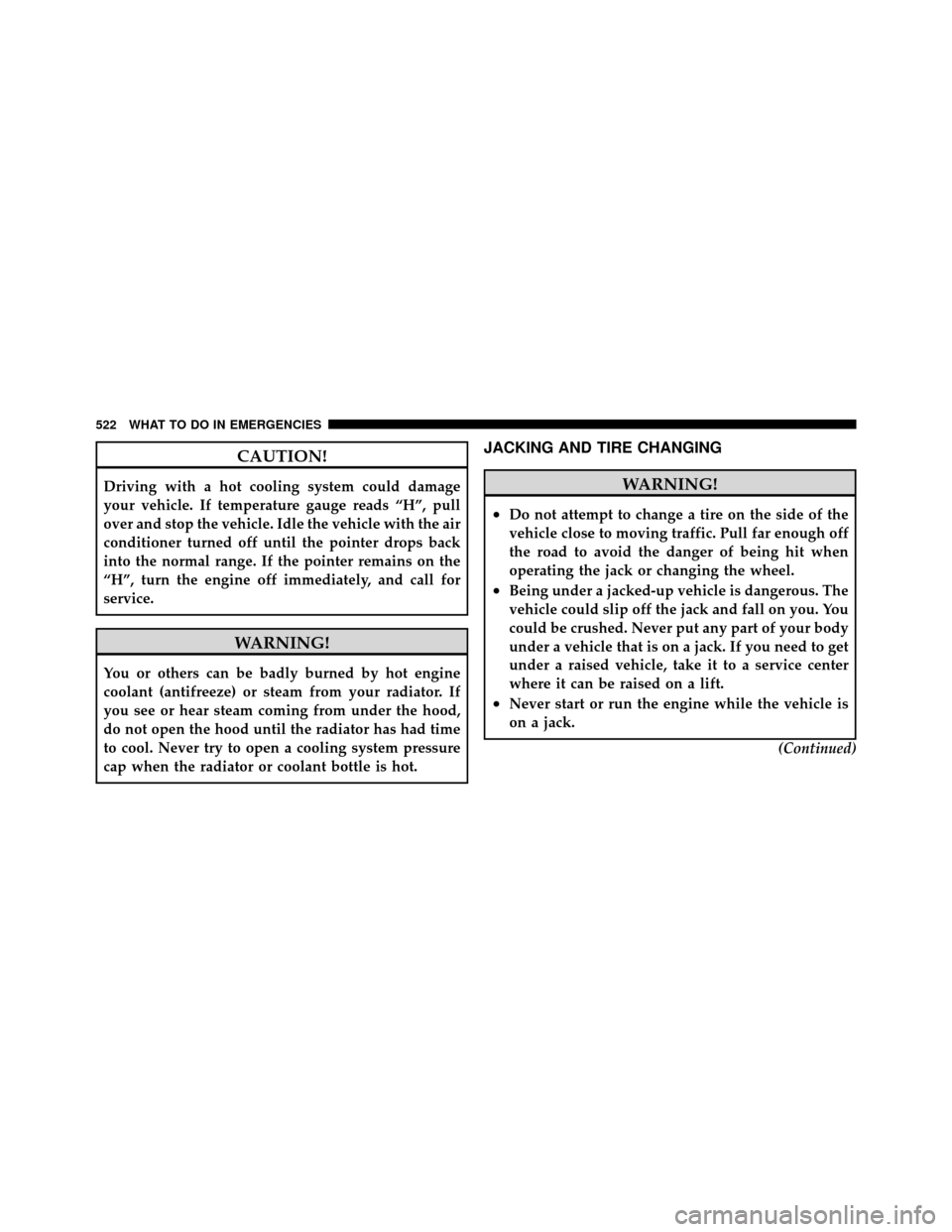
CAUTION!
Driving with a hot cooling system could damage
your vehicle. If temperature gauge reads “H”, pull
over and stop the vehicle. Idle the vehicle with the air
conditioner turned off until the pointer drops back
into the normal range. If the pointer remains on the
“H”, turn the engine off immediately, and call for
service.
WARNING!
You or others can be badly burned by hot engine
coolant (antifreeze) or steam from your radiator. If
you see or hear steam coming from under the hood,
do not open the hood until the radiator has had time
to cool. Never try to open a cooling system pressure
cap when the radiator or coolant bottle is hot.
JACKING AND TIRE CHANGING
WARNING!
•Do not attempt to change a tire on the side of the
vehicle close to moving traffic. Pull far enough off
the road to avoid the danger of being hit when
operating the jack or changing the wheel.
•Being under a jacked-up vehicle is dangerous. The
vehicle could slip off the jack and fall on you. You
could be crushed. Never put any part of your body
under a vehicle that is on a jack. If you need to get
under a raised vehicle, take it to a service center
where it can be raised on a lift.
•Never start or run the engine while the vehicle is
on a jack.(Continued)
522 WHAT TO DO IN EMERGENCIES
Page 572 of 652
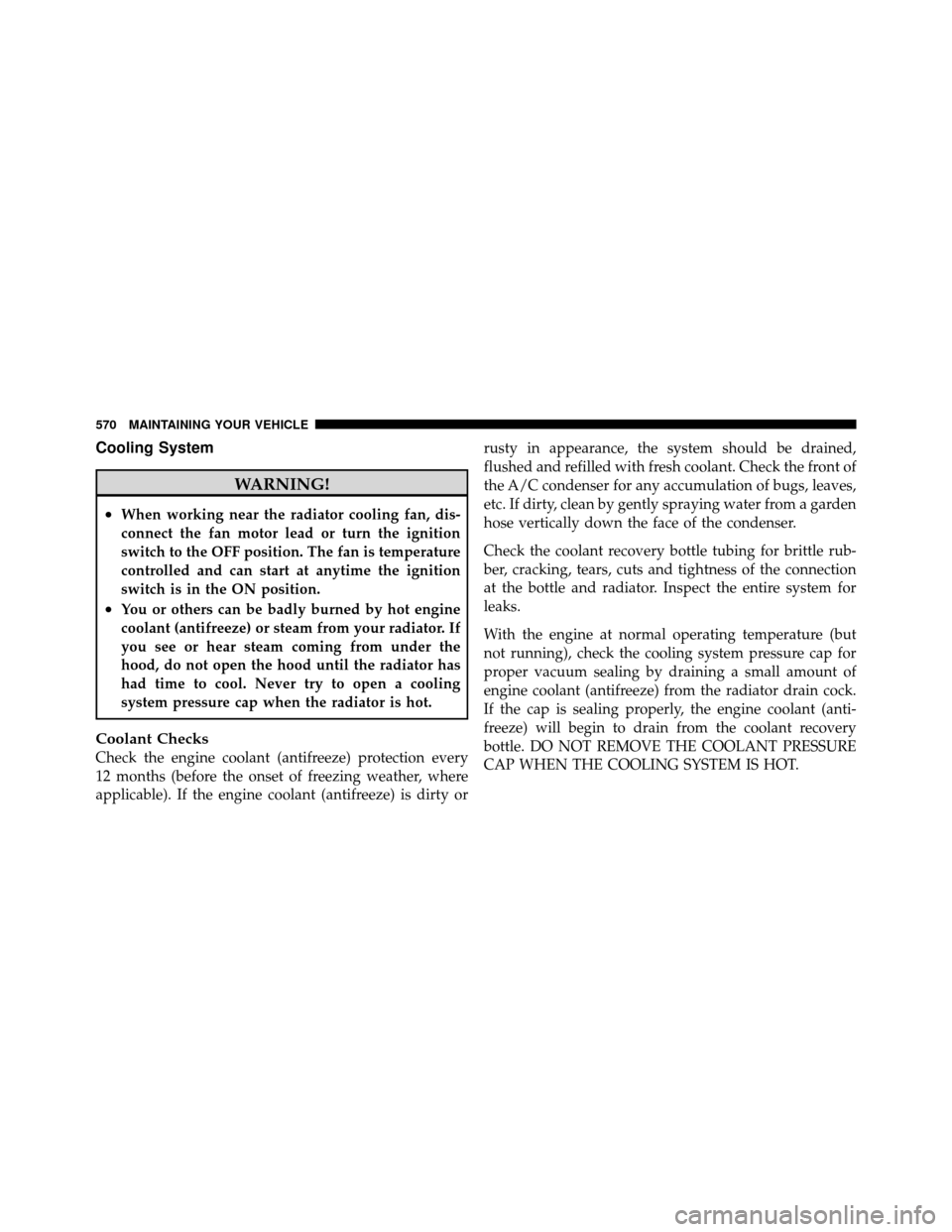
Cooling System
WARNING!
•When working near the radiator cooling fan, dis-
connect the fan motor lead or turn the ignition
switch to the OFF position. The fan is temperature
controlled and can start at anytime the ignition
switch is in the ON position.
•You or others can be badly burned by hot engine
coolant (antifreeze) or steam from your radiator. If
you see or hear steam coming from under the
hood, do not open the hood until the radiator has
had time to cool. Never try to open a cooling
system pressure cap when the radiator is hot.
Coolant Checks
Check the engine coolant (antifreeze) protection every
12 months (before the onset of freezing weather, where
applicable). If the engine coolant (antifreeze) is dirty orrusty in appearance, the system should be drained,
flushed and refilled with fresh coolant. Check the front of
the A/C condenser for any accumulation of bugs, leaves,
etc. If dirty, clean by gently spraying water from a garden
hose vertically down the face of the condenser.
Check the coolant recovery bottle tubing for brittle rub-
ber, cracking, tears, cuts and tightness of the connection
at the bottle and radiator. Inspect the entire system for
leaks.
With the engine at normal operating temperature (but
not running), check the cooling system pressure cap for
proper vacuum sealing by draining a small amount of
engine coolant (antifreeze) from the radiator drain cock.
If the cap is sealing properly, the engine coolant (anti-
freeze) will begin to drain from the coolant recovery
bottle. DO NOT REMOVE THE COOLANT PRESSURE
CAP WHEN THE COOLING SYSTEM IS HOT.
570 MAINTAINING YOUR VEHICLE
Page 575 of 652
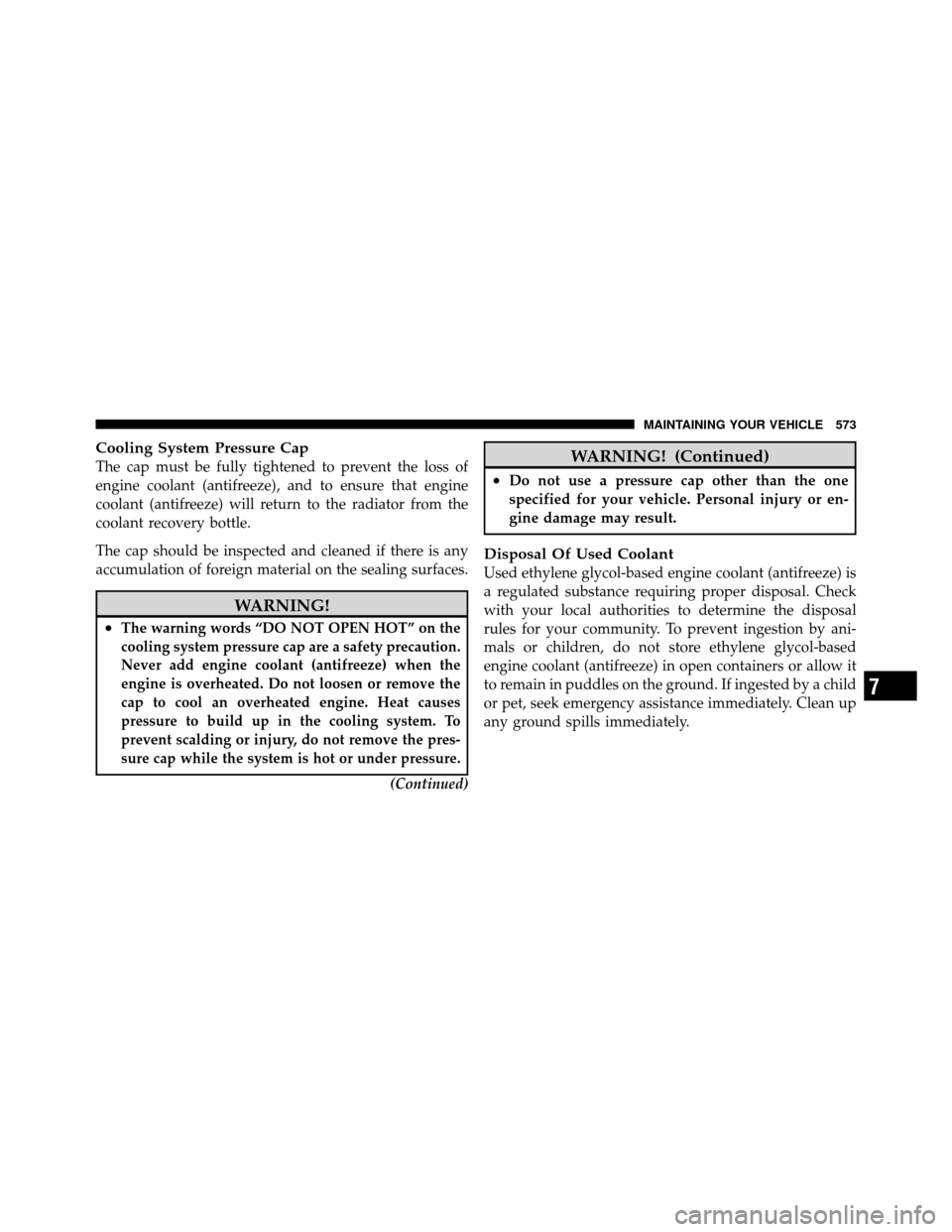
Cooling System Pressure Cap
The cap must be fully tightened to prevent the loss of
engine coolant (antifreeze), and to ensure that engine
coolant (antifreeze) will return to the radiator from the
coolant recovery bottle.
The cap should be inspected and cleaned if there is any
accumulation of foreign material on the sealing surfaces.
WARNING!
•The warning words “DO NOT OPEN HOT” on the
cooling system pressure cap are a safety precaution.
Never add engine coolant (antifreeze) when the
engine is overheated. Do not loosen or remove the
cap to cool an overheated engine. Heat causes
pressure to build up in the cooling system. To
prevent scalding or injury, do not remove the pres-
sure cap while the system is hot or under pressure.
(Continued)
WARNING! (Continued)
•Do not use a pressure cap other than the one
specified for your vehicle. Personal injury or en-
gine damage may result.
Disposal Of Used Coolant
Used ethylene glycol-based engine coolant (antifreeze) is
a regulated substance requiring proper disposal. Check
with your local authorities to determine the disposal
rules for your community. To prevent ingestion by ani-
mals or children, do not store ethylene glycol-based
engine coolant (antifreeze) in open containers or allow it
to remain in puddles on the ground. If ingested by a child
or pet, seek emergency assistance immediately. Clean up
any ground spills immediately.
7
MAINTAINING YOUR VEHICLE 573
Page 576 of 652
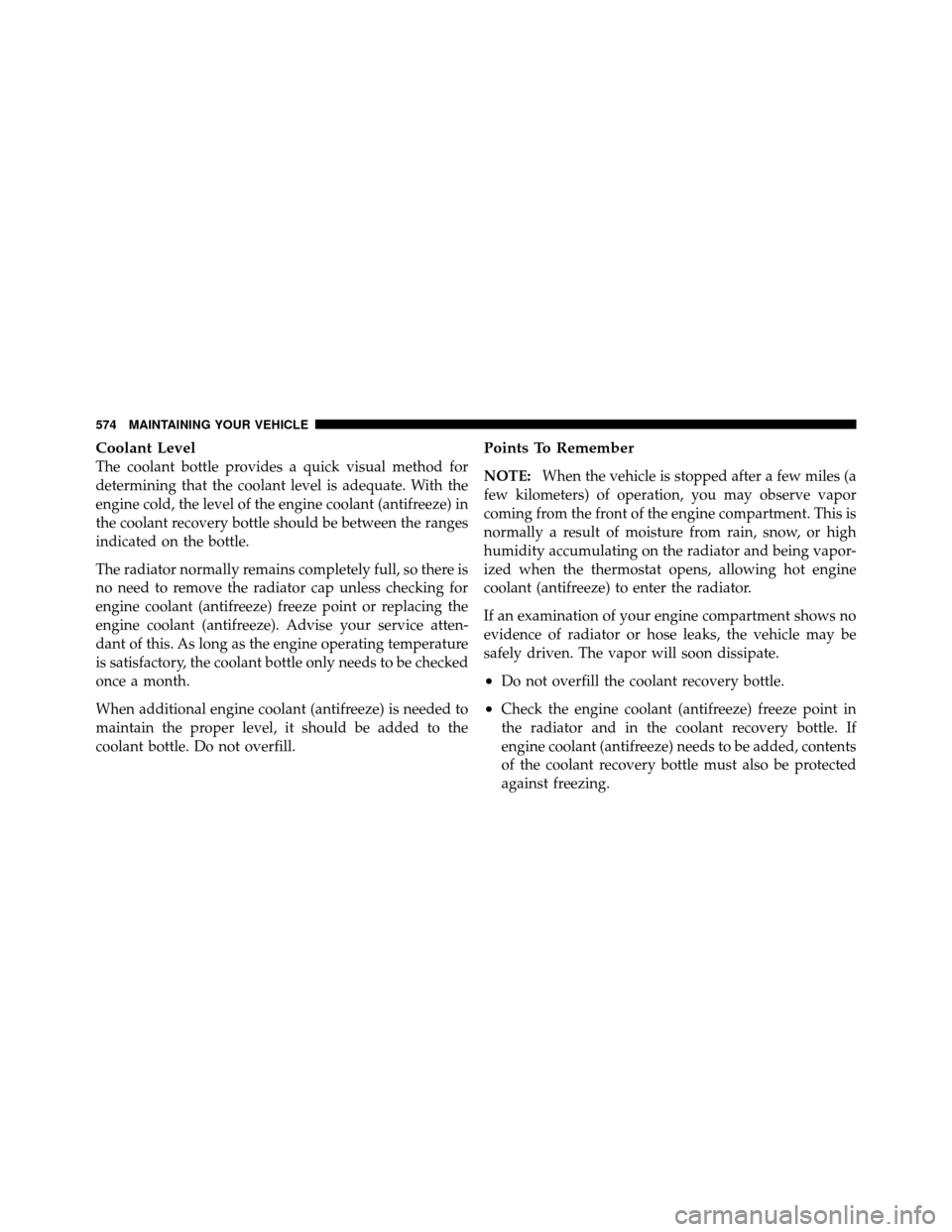
Coolant Level
The coolant bottle provides a quick visual method for
determining that the coolant level is adequate. With the
engine cold, the level of the engine coolant (antifreeze) in
the coolant recovery bottle should be between the ranges
indicated on the bottle.
The radiator normally remains completely full, so there is
no need to remove the radiator cap unless checking for
engine coolant (antifreeze) freeze point or replacing the
engine coolant (antifreeze). Advise your service atten-
dant of this. As long as the engine operating temperature
is satisfactory, the coolant bottle only needs to be checked
once a month.
When additional engine coolant (antifreeze) is needed to
maintain the proper level, it should be added to the
coolant bottle. Do not overfill.
Points To Remember
NOTE:When the vehicle is stopped after a few miles (a
few kilometers) of operation, you may observe vapor
coming from the front of the engine compartment. This is
normally a result of moisture from rain, snow, or high
humidity accumulating on the radiator and being vapor-
ized when the thermostat opens, allowing hot engine
coolant (antifreeze) to enter the radiator.
If an examination of your engine compartment shows no
evidence of radiator or hose leaks, the vehicle may be
safely driven. The vapor will soon dissipate.
•Do not overfill the coolant recovery bottle.
•Check the engine coolant (antifreeze) freeze point in
the radiator and in the coolant recovery bottle. If
engine coolant (antifreeze) needs to be added, contents
of the coolant recovery bottle must also be protected
against freezing.
574 MAINTAINING YOUR VEHICLE
Page 577 of 652
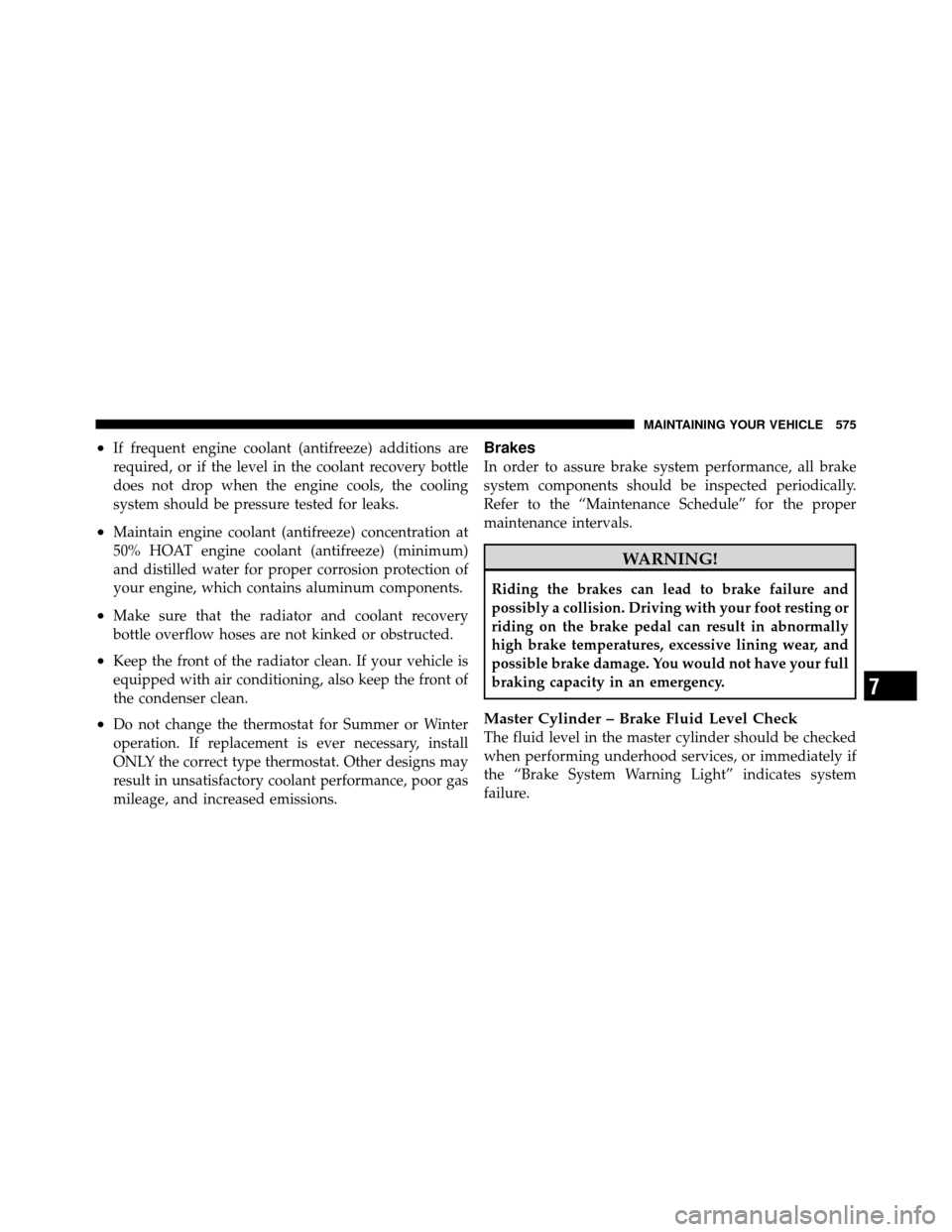
•If frequent engine coolant (antifreeze) additions are
required, or if the level in the coolant recovery bottle
does not drop when the engine cools, the cooling
system should be pressure tested for leaks.
•Maintain engine coolant (antifreeze) concentration at
50% HOAT engine coolant (antifreeze) (minimum)
and distilled water for proper corrosion protection of
your engine, which contains aluminum components.
•Make sure that the radiator and coolant recovery
bottle overflow hoses are not kinked or obstructed.
•Keep the front of the radiator clean. If your vehicle is
equipped with air conditioning, also keep the front of
the condenser clean.
•Do not change the thermostat for Summer or Winter
operation. If replacement is ever necessary, install
ONLY the correct type thermostat. Other designs may
result in unsatisfactory coolant performance, poor gas
mileage, and increased emissions.
Brakes
In order to assure brake system performance, all brake
system components should be inspected periodically.
Refer to the “Maintenance Schedule” for the proper
maintenance intervals.
WARNING!
Riding the brakes can lead to brake failure and
possibly a collision. Driving with your foot resting or
riding on the brake pedal can result in abnormally
high brake temperatures, excessive lining wear, and
possible brake damage. You would not have your full
braking capacity in an emergency.
Master Cylinder – Brake Fluid Level Check
The fluid level in the master cylinder should be checked
when performing underhood services, or immediately if
the “Brake System Warning Light” indicates system
failure.
7
MAINTAINING YOUR VEHICLE 575
Page 634 of 652
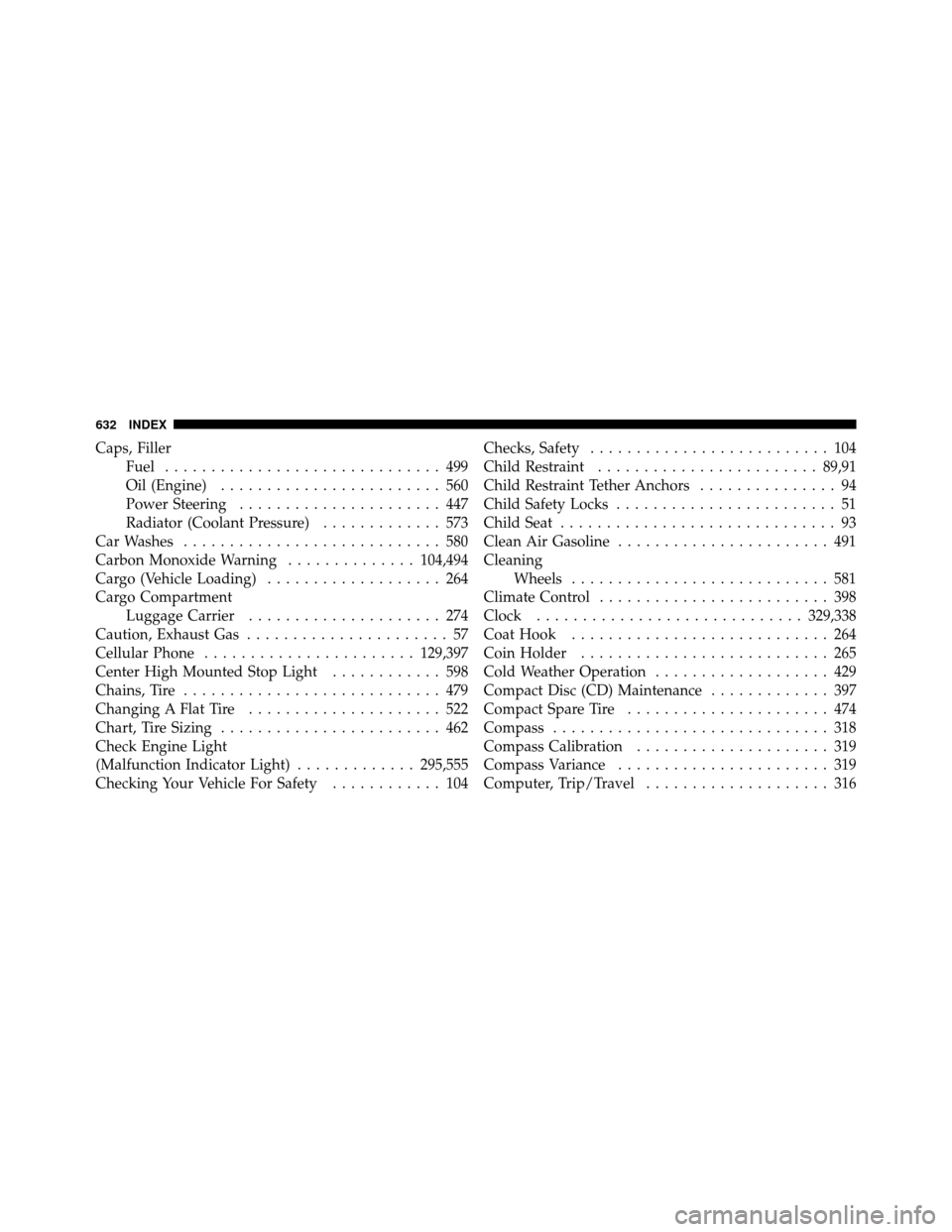
Caps, FillerFuel .............................. 499
Oil (Engine) ........................ 560
Power Steering ...................... 447
Radiator (Coolant Pressure) ............. 573
Car Washes ............................ 580
Carbon Monoxide Warning ..............104,494
Cargo (Vehicle Loading) ................... 264
Cargo Compartment Luggage Carrier ..................... 274
Caution, Exhaust Gas ...................... 57
Cellular Phone ....................... 129,397
Center High Mounted Stop Light ............ 598
Chains, Tire ............................ 479
Changing A Flat Tire ..................... 522
Chart, Tire Sizing ........................ 462
Check Engine Light
(Malfunction Indicator Light) .............295,555
Checking Your Vehicle For Safety ............ 104Checks, Safety
.......................... 104
Child Restraint ........................ 89,91
Child Restraint Tether Anchors ............... 94
Child Safety Locks ........................ 51
Child Seat .............................. 93
Clean Air Gasoline ....................... 491
Cleaning Wheels ............................ 581
Climate Control ......................... 398
Clock ............................. 329,338
Coat Hook ............................ 264
Coin Holder ........................... 265
Cold Weather Operation ................... 429
Compact Disc (CD) Maintenance ............. 397
Compact Spare Tire ...................... 474
Compass .............................. 318
Compass Calibration ..................... 319
Compass Variance ....................... 319
Computer, Trip/Travel .................... 316
632 INDEX
Page 635 of 652

ConnectorUCI .............................. 352
Universal Consumer Interface (UCI) ....... 352
Conserving Fuel ........................ 314
Console .............................. 265
Console, Floor .......................... 265
Console, Overhead ....................... 232
Console, Removable ...................... 269
Contract, Service ........................ 623
Coolant Pressure Cap (Radiator Cap) .......... 573
Cooling System ......................... 570
Adding Coolant (Antifreeze) ............. 572
Coolant Capacity ..................... 599
Coolant Level .................... 570,574
Disposal of Used Coolant ............... 573
Drain, Flush, and Refill ................ 571
Inspection .......................... 574
Points to Remember .................. 574 Pressure Cap
........................ 573
Radiator Cap ....................... 573
Selection of Coolant (Antifreeze) ....571,599,600
Cupholders ......................... 254,585
Customer Assistance ..................... 621
Data Recorder, Event ...................... 88
Daytime Running Lights ................... 206
Dealer Service .......................... 557
Defroster, Rear Window ................... 273
Defroster, Windshield .................. 106,412
Diagnostic System, Onboard ................ 554
Dimmer Control ........................ 204
Dipsticks Automatic Transmission ................ 579
Oil (Engine) ........................ 558
Power Steering ...................... 447
Disabled Vehicle Towing ................... 547
10
INDEX 633
Page 645 of 652
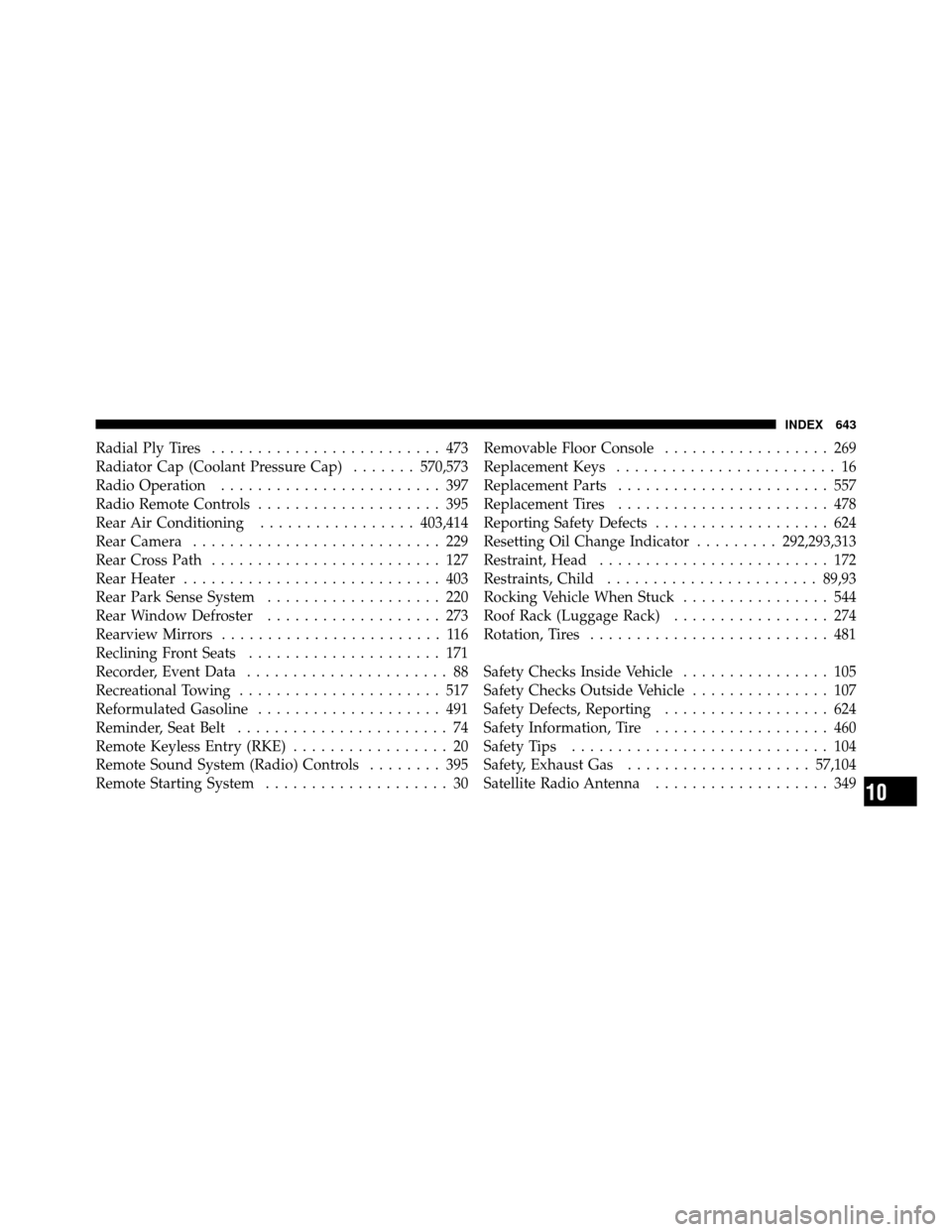
Radial Ply Tires......................... 473
Radiator Cap (Coolant Pressure Cap) .......570,573
Radio Operation ........................ 397
Radio Remote Controls .................... 395
Rear Air Conditioning .................403,414
Rear Camera ........................... 229
Rear Cross Path ......................... 127
Rear Heater ............................ 403
Rear Park Sense System ................... 220
Rear Window Defroster ................... 273
Rearview Mirrors ........................ 116
Reclining Front Seats ..................... 171
Recorder, Event Data ...................... 88
Recreational Towing ...................... 517
Reformulated Gasoline .................... 491
Reminder, Seat Belt ....................... 74
Remote Keyless Entry (RKE) ................. 20
Remote Sound System (Radio) Controls ........ 395
Remote Starting System .................... 30 Removable Floor Console
.................. 269
Replacement Keys ........................ 16
Replacement Parts ....................... 557
Replacement Tires ....................... 478
Reporting Safety Defects ................... 624
Resetting Oil Change Indicator .........292,293,313
Restraint, Head ......................... 172
Restraints, Child ....................... 89,93
Rocking Vehicle When Stuck ................ 544
Roof Rack (Luggage Rack) ................. 274
Rotation, Tires .......................... 481
Safety Checks Inside Vehicle ................ 105
Safety Checks Outside Vehicle ............... 107
Safety Defects, Reporting .................. 624
Safety Information, Tire ................... 460
Safety Tips ............................ 104
Safety, Exhaust Gas .................... 57,104
Satellite Radio Antenna ................... 349
10
INDEX 643